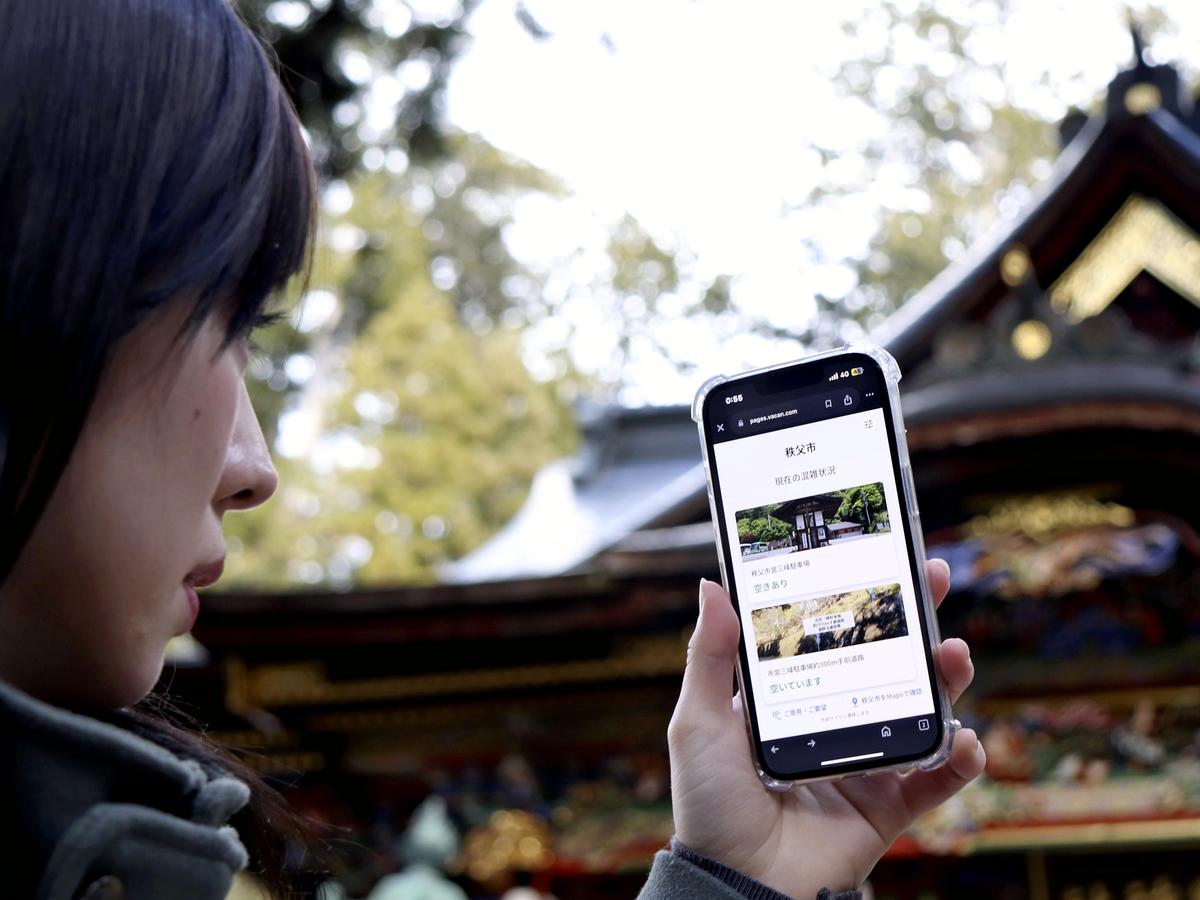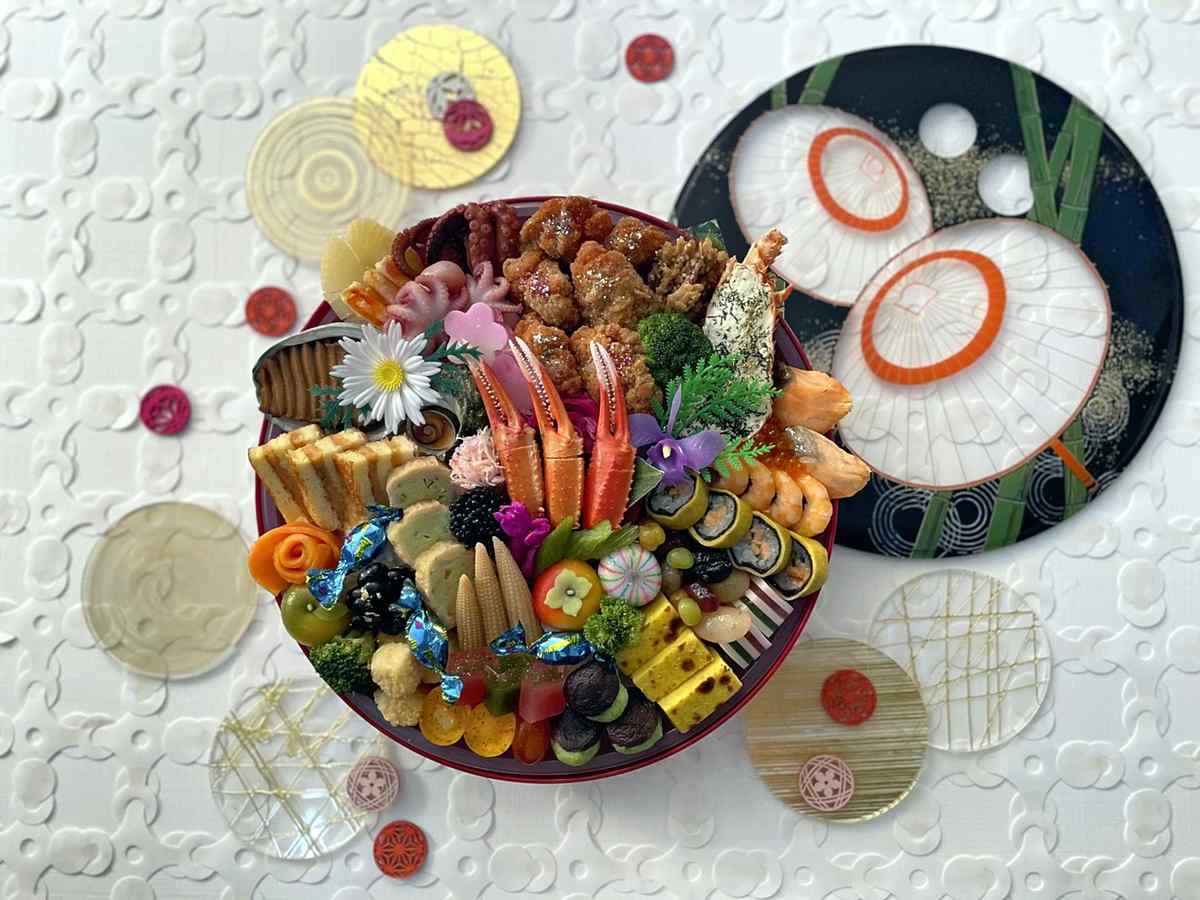AI Breathes Fresh Life into New Year’s Customs; Avoiding Car Congestion near Shrines, Adding New Ideas to Cuisine

Vacan, Inc.’s website shows the status of congestion at a municipal parking lot and roads near Mitsumine Shrine in this photo taken on Dec. 24 in Chichibu, Saitama Prefecture.
12:10 JST, December 30, 2024
New Year’s Day is right around the corner.
Artificial intelligence continues to spread rapidly in society, and the technology is being utilized for a variety of purpose during the New Year’s holidays.
Providing information to drivers on congestion at parking lots and roads near shrines and devising new menus for osechi dishes (a cuisine eaten on New Year’s Day) are among the new diverse New Year’s applications of AI technology.
Additionally, while more people are stepping away from the long-lasting tradition of sending New Year’s cards to relatives and friends, an AI service has emerged that suggests novel designs for the cards, adding new color to a long-cherished custom.
Avoiding congestion
Mitsumine Shrine in Chichibu, Saitama Prefecture, attracts about 30,000 New Year’s visitors every year.
When the dedicated website is opened on a smartphone, a notification displays “some vacancies,” referring to empty parking spaces at a municipal parking lot near the shrine.
When the parking lot is crowded, the notification reads “full.” The website can also notify users that “There is a traffic jam on the road near the parking lot.”
The website is managed by Vacan, Inc., a Tokyo-based IT company. Using footage from four cameras installed near the shrine, AI analyzes how crowded the area is and displays that information on the webpage.
The shrine is located deep in the mountains, with traffic jams lasting several hours and occurring frequently during the New Year holidays.
In light of this, the city government of Chichibu, introduced the system in February this year in a bid to reduce the congestion.
The year 2025 will be the first year the system is utilized for New Year’s worshippers visiting the shrine.
“It is convenient if I can know in advance how congested the parking lots or nearby roads are,” said a 59-year-old man from Fujisawa, Kanagawa Prefecture, who was visiting the shrine on a day of late December. “I can use the time more effectively.”
Vacan’s service has been adopted at more than 20,000 commercial facilities across the country and used at such major shrines as Ise Jingu Shrine in Mie Prefecture and Dazaifu Tenmangu Shrine in Fukuoka Prefecture.
“We would like to expand our service for greater convenience,” said Takanobu Kawano, the company’s CEO.
Unexpectedness prompts greater response

A sample of Aeon Retail Co.’s AI-developed osechi dishes
AI has also breathed fresh life into osechi dishes, which add color to the table during the New Year holidays.
This year, Aeon Retail Co. has marketed its first osechi range developed by generative AI. It was developed based on AI-generated images using such prompts as “future,” “luxury” and “color.”
They are novel New Year’s Day dishes containing not only standard foods, such as salted herring roes and boiled abalones, but also chocolate and deep-fried chicken sprinkled with decorative dust in five different colors.
“The unexpectedness of using AI for Osechi, a Japanese traditional New Year’s Day dish, has received a response greater than we had expected,” said an official of Aeon Retail.
According to Fuji Keizai Co., a Tokyo-based research firm, the market for osechi dishes contained in stacked boxes in 2024 declined 1.5% from the previous year to ¥84.3 billion.
“How to add value equivalent to the increased price is the key in the sales battle over osechi dishes,” said Miwa Funase, a senior researcher at Fuji Keizai. “Entertainment features such as ‘AI Osechi’ will be needed more.”
AI New Year’s cards
Although sending New Year’s cards has been on the decline, one company has launched a new online service for the tradition, making use of AI. Greeting Works Co., an Osaka-based firm that handles postcard printing, uses AI technology to suggest novel designs for New Year’s cards.
“We would like to make writing New Year’s cards easier with the use of AI,” said an official of Greeting Works.
"Science & Nature" POPULAR ARTICLE
-

Mass Oyster Die-Offs Confirmed in Japan’s Seto Inland Sea; High Water Temperature Cited as Primary Cause
-

Genome Study Reveals Milestone in History of Cat Domestication
-

Big Leap in Quest to Get to Bottom of Climate Ice Mystery
-

Security Camera Footage Vulnerable to Outside Access; Investigation Finds 3,000 Pieces Exposed Online
-

Paws on Parade: Nairobi’s Dogs Dazzle at ‘Pawchella’
JN ACCESS RANKING
-

Keidanren Chairman Yoshinobu Tsutsui Visits Kashiwazaki-Kariwa Nuclear Power Plant; Inspects New Emergency Safety System
-

Imports of Rare Earths from China Facing Delays, May Be Caused by Deterioration of Japan-China Relations
-

University of Tokyo Professor Discusses Japanese Economic Security in Interview Ahead of Forum
-

Japan Pulls out of Vietnam Nuclear Project, Complicating Hanoi’s Power Plans
-

Govt Aims to Expand NISA Program Lineup, Abolish Age Restriction

























